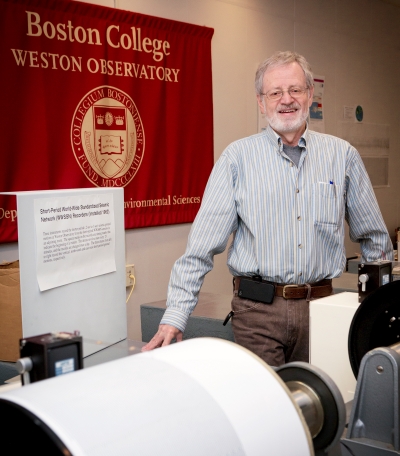
By
Almost two months into his appointment as director of the University’s Weston Observatory, Associate Professor of Earth and Environmental Sciences Alan Kafka says he is excited to further the mission of one of the world’s leading earthquake monitoring and research institutes.
“The Weston Observatory enjoys a proud legacy and will continue to play a significant role in the future of Boston College,” said Kafka, who has been involved with the work of the observatory — located about 10 miles from campus in the town of Weston — during the course of his 30-year career at BC. “I view it as a priceless resource to our campus and the communities we serve.”
A geophysicist who specializes in seismology, Kafka assumed the post at the start of the fall semester, taking over for long-time director and Professor of Earth and Environmental Sciences John Ebel, who is now serving as chairman of the department.
Kafka said the observatory, which has been recording earthquakes since the 1930s, will continue to carry out a three-tiered mission of scientific research, public outreach and science education in Boston-area communities.
Research takes place on a global scale, supporting the work of professors and government scientists around the world. The observatory’s seismic instruments support the New England Seismic Network and the World-Wide Standardized Seismic Network.
Public outreach has grown to include a significant role in earthquake mitigation, ranging from research into forecasting seismic activity and providing guidance to agencies such as the Massachusetts Emergency Management Agency.
Science education includes school visits and tours, as well as the observatory’s Educational Seismology Program, which places seismographs in K-12 classrooms and public libraries in support of science education and outreach.
The observatory remains firmly rooted in its history, Kafka said, a direct result of the work of early Jesuit scholars in the earth sciences whose religious order supplied one of the first global networks for the collection and dissemination of earthquake data. Visitors can still watch the seismographs roll, their delicate needles transcribing onto graph paper the movement of the earth below.
At the same time, the observatory has moved its data onto high-tech networks of servers to offer access to a global audience. The staff is currently developing new software to provide earthquake data to scholars and students of all ages.
This melding of old and new is part of the challenge of leading the observatory, Kafka said.
“An earthquake observatory is a unique place,” he said. “It’s a research laboratory, it’s a distributed network for earthquake monitoring and research, and it’s a provider of educational and public outreach resources about all aspects of seismology and earthquake hazards.
“This is an exciting time in the field of seismology, particularly in the cutting-edge use of the Internet and social networking to advance seismological research and mitigate earthquake hazards. We are excited about the possibilities.”



